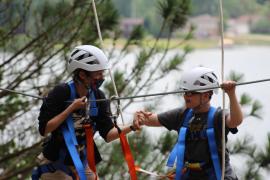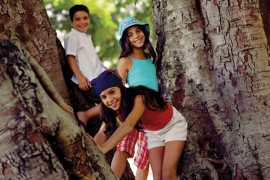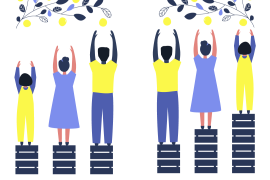Cultural considerations in camp programming may not be in the forefront of individual or organizational thinking. With all the preparation and planning that we do, is it really necessary to add yet another element for consideration? To not do so would be contrary to the complete package of what risk management should ultimately encompass. If an instructor or organization acknowledges the concept of environmental and human factors as contributing causes to accidents, incidents, and near misses, then we cannot dismiss the human dimension factors such as culture, race, abilities, and other diversity-related issues.
The Construct of Culture
Definitions of culture are numerous, and there is no single definition that all social scientists or anthropologists would heartily accept. And, there are several approaches that are relevant to understanding culture (e.g., communication interactions/patterns, problem solving). We have adopted the following definition for its ease of comprehension and utility: “A learned set of shared interpretations about beliefs, values, and norms which affect the behaviors of a relatively large group of people (Lustig and Koester 1999).”
A definition that is more lengthy, yet more fully captures the essence of meaning is: “Culture consists of patterns, explicit and implicit, of and for behavior acquired and transmitted by symbols, constituting the distinctive achievements of human groups, including their embodiments in artifacts; the essential core of culture consists of traditional (i.e., historically derived and selected) ideas, especially attached values (Banks 2001).”
Societal Changes and Challenges for the Field
Following the tragic events of “9-11,” as Americans, we do not think it would be a bold statement to say people of Middle Eastern descent are now experiencing numerous risk management issues in their lives. If you take some time to consider innumerable populations who have endured injustice by virtue of their race/culture or class, for instance, what do you see, feel, and imagine their own personal and or professional “risk management” concerns might be?
It is troubling and inauspicious that the question, “What does culture have to do with risk management?” is asked so often. People with this lack of awareness — who are completely ineffective with intercultural communication skills — typically function at a cultural competency level known as cultural blindness. Cultural blindness is defined as, “denying that any difference exists between one’s own culture and the culture of another (Gray & Roberts 2001; Lustig & Koester 1999; Randall 1989).”
Through workshops and a variety of appropriate training opportunities, the level of consciousness can be raised from blindness to a more competent view. People can discover how the assortment of features and characteristics relating to culture all intersect with managing the emotional and physical risks of both the staff and campers we serve. The Humanistic Risk Management Model© provides a visual overview of these complex concepts. With an emphasis on the “emotional” factors, it is important to note this component is much less developed in the field, and the overall model is therefore a work in progress.
In a 2001 WRMC workshop in Wisconsin, we presented figures and statistics on the ever-changing demographics in the United States that illustrate the United States is experiencing an increasingly diverse population. While the outdoor profession still reflects the dominant white culture, the Census Bureau is projecting that within thirty years European American people will be the minority population in the United States (Census 2000). A recent article supporting this trend titled “The Future of Experiential Education” by Dr. Dan Garvey was part of his keynote speech at the 2002 Association for Experiential Education (AEE) Intermountain Regional Conference. He stated, “If we don’t have adequate representation from diverse populations, then how will we possibly survive in the future?” (Garvey 2002, p.19).
Often representation of people from diverse ethnic origins is limited at conferences hosted by such organizations as American Camping Association, Association for Experiential Education, and the Wilderness Risk Management Conference. Nonetheless, people from various backgrounds do, in fact, participate in our camp programs — people of various races, religions, and cultures. Statistically, however, these groups are not involved at the same level (e.g., fewer in number) as the dominant culture.
Why is that? For example based on research, it is our strong opinion there are safety and access issues — for these and other populations — that hinder participation both from a staffing and participant perspective.
According to Ewert (1996), “Although in recent years outdoor education has made progress in meeting the multicultural challenge, few researchers and practitioners have moved beyond a basic level of inclusiveness will take place when outdoor educators allow elements of diverse cultures to reshape basic concepts, theories, and practice.” As outdoor educators, it is our responsibility and duty to restructure our industry to be inclusive and welcoming.
Although the numbers may be smaller on average, people from various cultural backgrounds do attend camp programs. There are “differences” to varying degrees that need to be carefully considered, researched, and understood. According to Roberts and Rodriquez (1999), for example, based on one’s culture there are differences in attitudes towards the outdoors, varying experiences with adventure-based activities, assorted learning styles, and a range of constraints to full enjoyment and skill development.
Dr. Karen Warren, a well-known experiential education professor from Hampshire College, wrote her doctoral dissertation on “Unpacking the Knapsack of Outdoor Experiential Education: Race, Gender and Class Sensitive Outdoor Leadership” (Warren 1999) in which she combines the concepts of social justice and leadership theories. Her premise reinforces a challenge to this profession to begin exploring these issues as critically as we examine all technical aspects of our work — knowing the breaking strength of an eleven millimeter rope, knowing the correct first-aid protocol for a sprained ankle, knowing how to climb a 5.11+ rock face, and having and wearing the “best” gear. Warren also prompts the field to scrutinize the AEE accreditation standards, which barely touch the subject of social justice and unquestionably it should. Her ongoing work on “socially just outdoor leadership” is commendable and progressive. She is helping to break new ground and is one of the few scholars in our profession who has researched this vital subject matter.
As the population changes to reflect a new ethnic majority, camp counselors, and all who would provide outdoor-based programs, must be alert to the changes and challenges to this field. As inheritors of both programmatic and political power, today’s minority groups will be tomorrow’s majority and will decide whether to be involved as participants and/or leaders or demand for changes to occur for which we might not be ready. As counselors and camp directors, it is our responsibility to forge the connections between the programs that we operate and the diverse populations that must be better served.
Our organizations must examine the relevancy of the camp environment and our programs in general, and continue the discourse on the changing demographics of this country, as well as the training issues that staff may need to meet the emotional and cultural components of well-managed risks. The world is changing at a rapid pace and sometimes — as horrifically experienced on 9-11-01 — a disturbing rate. Our overview, understanding, and obligation as educators, reformists, therapists, counselors/instructors, and administrators are critical to our staff and campers — to their willingness to participate and to their opportunities for effective involvement.
Thinking in multiplicity about the needs and possible concerns of diverse constituents, and creating programs accordingly, is logical, responsible, and appropriate. The reason is, conscious or unconscious, cultural incompetency is pervasive in today’s society; our profession can give cultural mores, considerations, and concerns the attention they deserve — with just as much importance as appropriate gear, route selection, medical certifications, and similar program and administrative protocols. We have the opportunity through our programs to create a safe place for all by being sensitive to cultural differences and knowledgable about needs.
|
The Santa Fe Mountain Center: A model program The Santa Fe Mountain Center (SFMC) is a leading prototype for multicultural programming in this country. As an organization, it is faced with a series of risk management issues regarding both clientele and staff. The Center serves a diverse community including people of color (primarily Latino/a, Pueblo, and Southwestern Indian), people with HIV/AIDS, vulnerable youth who are present with a variety of interpersonal challenges, and women who have been violated by domestic and sexual violence. SFMC strives to be a relevant experiential program in the 21st century and to truly be a multicultural organization. One approach is to stay current with pressing social issues and another is to hire staff that represent and/or reflect the clientele we serve. Through mistakes and triumphs, the Center has learned the significance of cultural diversity and risk management. Perhaps one of the most important lessons learned has been the discovery of how pervasive dominant cultural norms and values are — and the negative and damaging effects they can have on other people and cultures. In order to create a positive environment, SFMC focuses on pertinent training, ongoing and open dialogue, and staff briefings that target cultural understanding and competency. |
References
Adams, M. (2000). Conceptual frameworks. In M. Adams, W.J. Blumenfeld, R. Castaneda, R., H.W. Hackman, M.L. Peters, & X. Zuniga (Eds.), Readings for diversity and social justice: An anthology on racism, anti-Semitism, sexism, heterosexism, ableism, and classism, pp. 5-9. New York, NY: Routledge.2.
Banks, J.A. (2001). Cultural diversity and education: Foundations, curriculum, and teaching, 4th ed. Boston, MA: Allyn & Bacon.
Ewert, A. (1996). Research in outdoor education: Our place on the porch. In L. McAvoy, L. Stringer, M. Bialeschki, and A. Young (Eds). Coalition for the Education in the Outdoors Third Research Symposium Proceedings (pp. 7-8). Cortland NY: Coalition for Education in the Outdoors.
Garvey, D. (2002, Summer). The future of adventure education. The Outdoor Network, (13)3, 1, 18-20, 29.
Gray, S. & Roberts, N.S. (2001, October). The impact of diversity and risk management: What’s the link and what might you be missing? Paper presented at the Wilderness Risk Management Conference. Lake Geneva, WI.
Lustig, M.W. & Koester, J. (1999). Intercultural competence: Interpersonal communication across cultures, 3rd ed. Reading, MA: Addison Wesley Longman.
Randall, D.E. (1989). Strategies for working with culturally diverse communities and clients. Unpublished manuscript. Washington, DC: Association for the Care of Children’s Health.
Roberts, N.S. & Gray, M.S. (1998). The impact of diversity issues on risk management. In J. Gookin (Ed.), Proceedings of the 1998 Wilderness Risk Management Conference, (pp. 26 29). Lander, WY: National Outdoor Leadership School.
Rodriquez, D.R & Roberts, N.S, (2001). Multicultural issues and outdoor education. (ERIC Digest). Charleston, WV: ERIC Document Reproduction Service No. EDO RC 996.
U.S. Bureau of the Census (2000). “Overview of race and Hispanic origin.” Retrieved on the World Wide Web, August 17, 2002. www.census.gov
Warren, K. (1999). Unpacking the knapsack of outdoor experiential education: Race, gender, and class sensitive outdoor leadership. (Unpublished Doctoral Dissertation, Graduate School of The Union Institute, 1999).
Authors note: A modified version of this paper first appeared in the Wilderness Risk Management Conference Proceedings, 2002.
M. Sky Gray, M.S., C.T.R.S., is the executive director for the Santa Fe Mountain Center. She serves on the Accreditation Council for the Association for Experiential Education and has been a practitioner in the field working with variety of populations for twenty years.
Nina S. Roberts, M.A., has been a practitioner in outdoor recreation and park management for twenty years. She currently works for the National Park Service while pursuing a Ph.D. at Colorado State University.
Both authors have significant experience with a variety of camps.
Originally published in the 2003 November/December issue of Camping Magazine.



